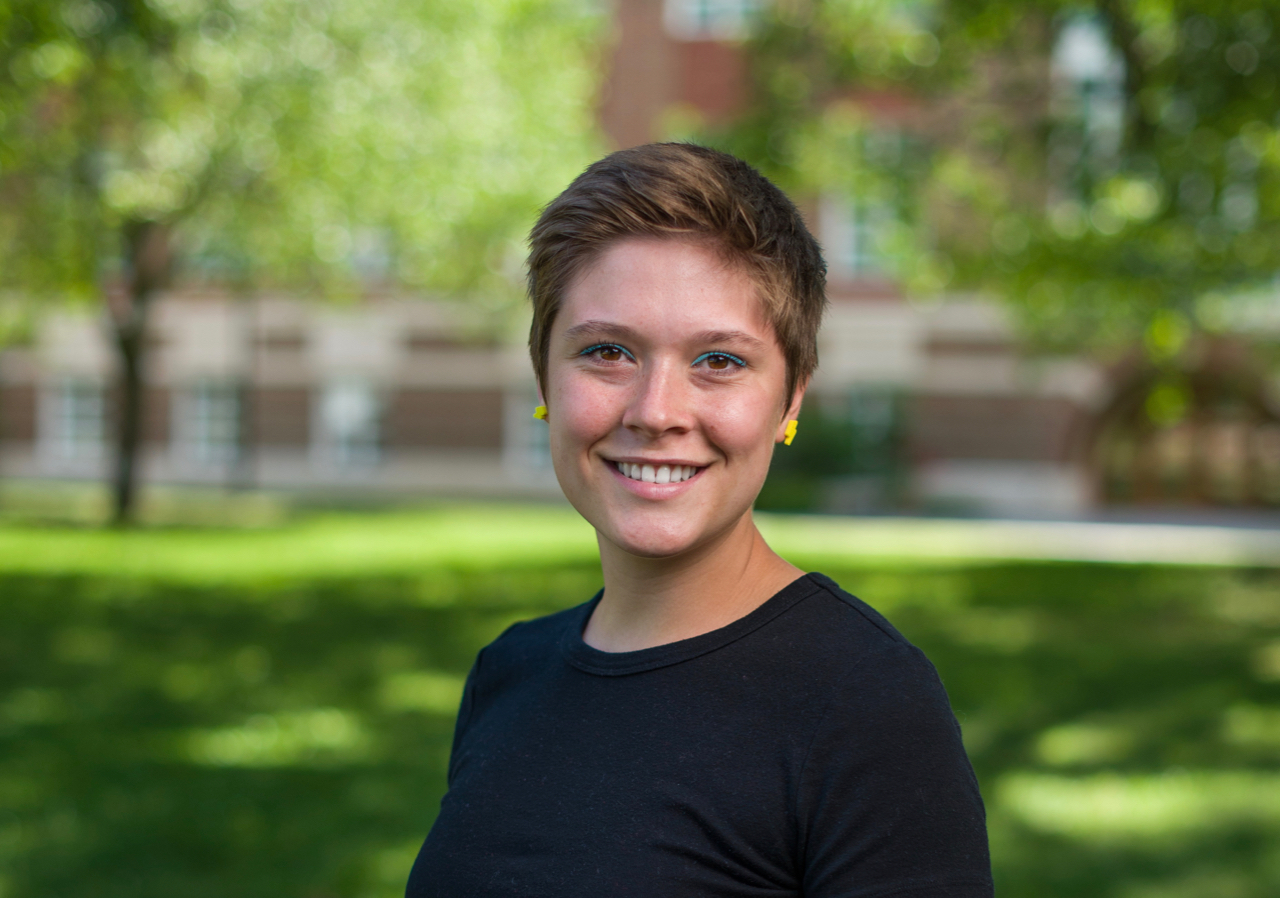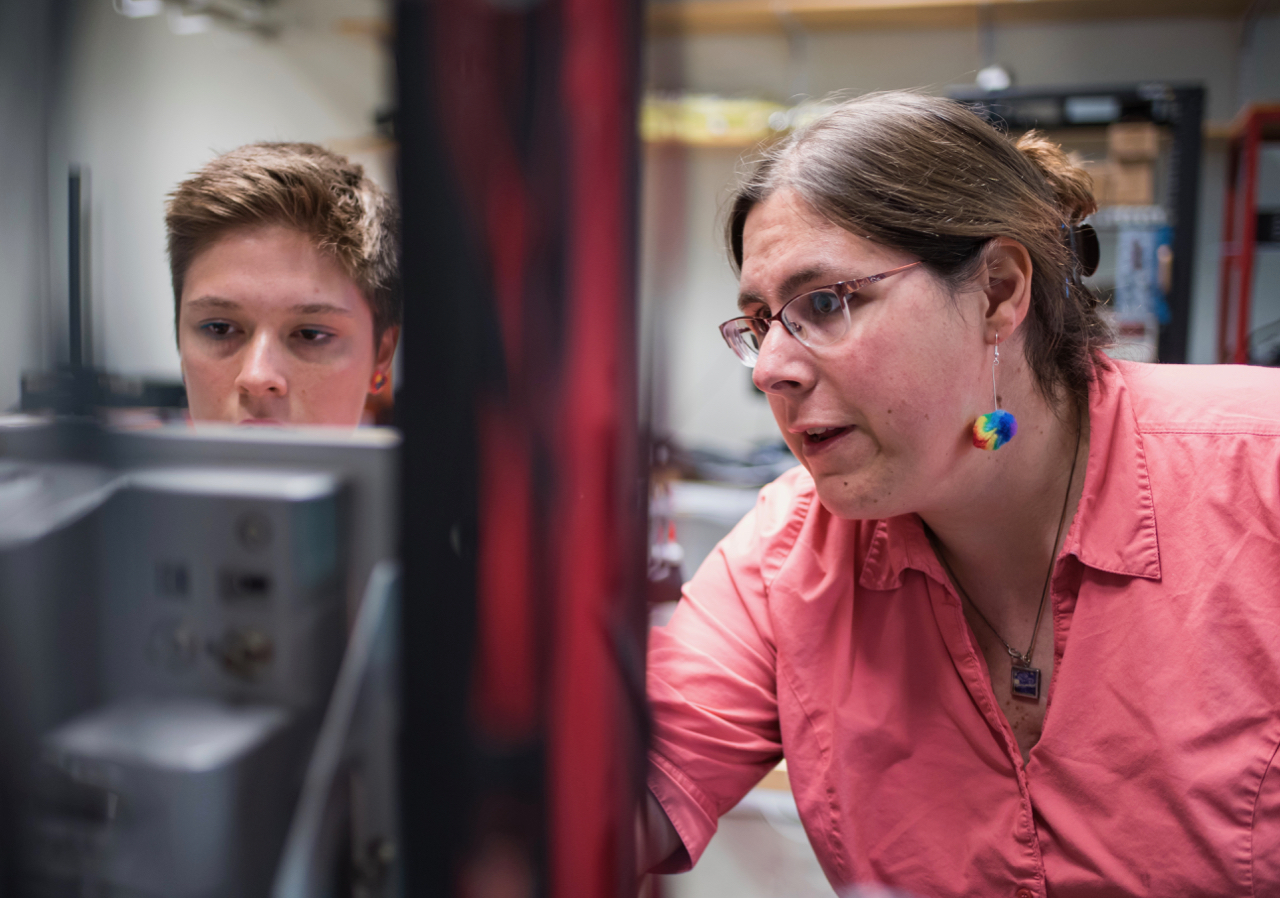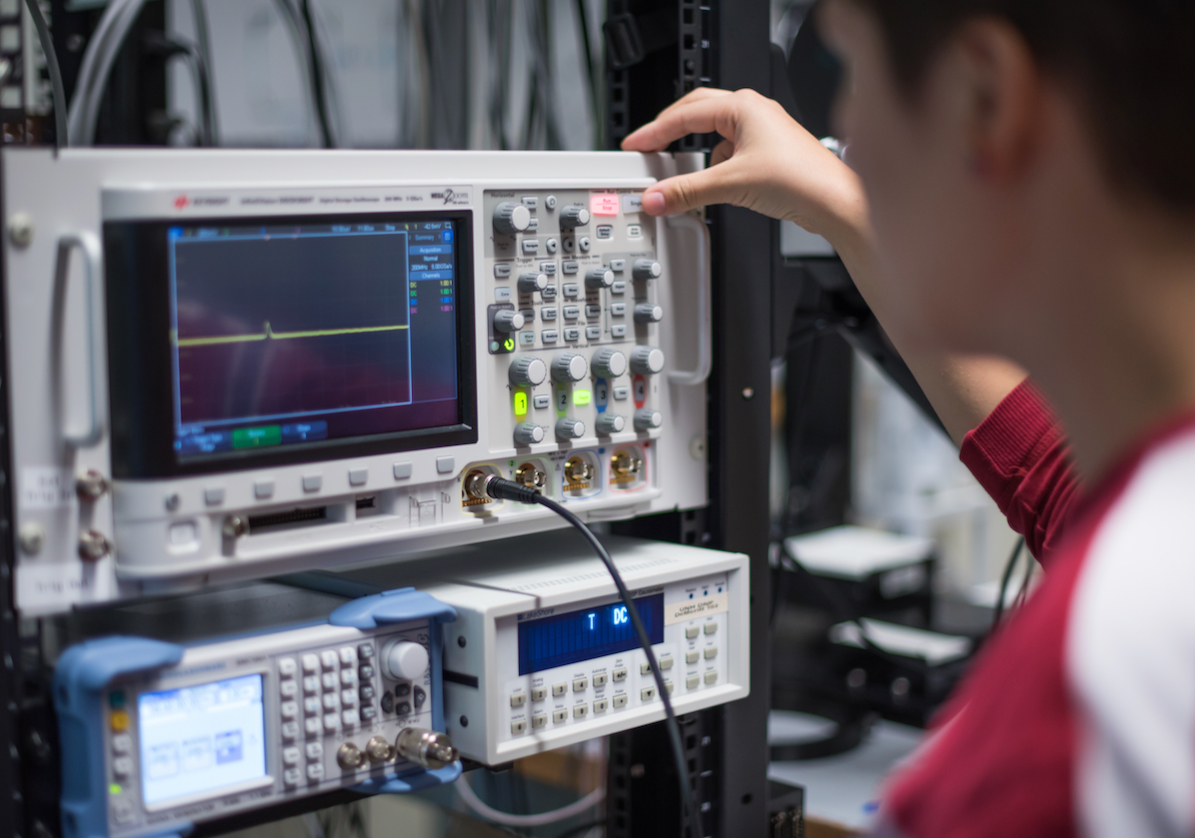Photos: Jeremy Gasowski/University of New Hampshire
The 2018-2019 Jefferson Science Associates Minority/Female Undergraduate Research Assistantship awardee spins opportunities for growth in science and throughout university campus.
University of New Hampshire Junior Alana Gudinas knows how to improvise. When a professor suggested she should apply for the 2018-2019 Jefferson Science Associates Minority/Female Undergraduate Research Assistantship, Gudinas took an unplanned, round-about route to ensure she was an appealing candidate.
Gudinas learned of the assistantship only weeks before the application deadline, had no qualifying project on the horizon, had never studied nuclear physics and was in the thick of wrapping up her semester, which included finishing her latest research project in computational astrophysics. Yet, Gudinas knew that the opportunity to apply for the assistantship offered by the U.S. Department of Energy’s Thomas Jefferson National Accelerator Facility was one she would not let pass.
First, in order to be eligible for the Jefferson Lab assistantship, Gudinas needed to have a project to propose to the application committee, along with a mentoring professor who had an association with the lab and would be willing to take Gudinas on, should she be awarded the assistantship.
“At first, I thought the application looked too hard,” Gudinas said. “Everything was piling up, and the deadline was two weeks after classes ended. I didn’t think I could apply and I didn’t even know who I would work with.”
Gudinas had admired University of New Hampshire Assistant Professor Elena Long for her involvement in the LGBTQ field.
“Engaging the community in science is important to me, and I knew she had a really cool lab that was doing all sorts of 3D printing,” Gudinas said.
She knew that Professor Long conducted research at Jefferson Lab and had several projects related to lab research. However, Gudinas says she knew nothing about the field of nuclear physics, even though it’s one that she had wanted to explore. After discussing the assistantship and potential projects with Long, Gudinas decided to focus on a project titled, “Efficiency of 3D-Printed Scintillation Particle Detectors” for the assistantship application.
“It sounded the weirdest, and I would get to use the cool 3D printer,” she laughed.
During her the research for her application, Gudinas and Long worked closely together to do a deep dive into the proposed project.
“Writing any project proposal is hard, because you have to do a lot of background research to understand your project,” Gudinas explained. “Part of that understanding is the theoretical motivation. Another part is learning about the tools and machines I’d be using.”
Project Could Save Time, Money and Increase Mobility
The end goal of the project was to create a custom particle detector that had the potential to be as efficient as a detector that researchers can buy.
“When you buy a regular scintillation detector, they come in a big plastic slab,” Gudinas explained. “If you want a specific piece or shape, you have to outsource it or you have to do it yourself. It takes a long time.”
If awarded the assistantship, Gudinas would be using a 3D printing technology to custom-create detectors.
“Ultimately, it would save on costs enormously would allow for unprecedented flexibility,” she said. “We could print these detectors in any shape or form that one can imagine. That would allow us to collect all sorts of data, save on cost, labor, time and could yield novel measurements.”
If successful, such custom-created detectors could one day be used in experiments in Jefferson Lab’s Continuous Electron Beam Accelerator Facility, a DOE Office of Science User Facility.
Lead-up to Using the “Cool 3D Printer”
Gudinas received the assistantship and began work right away, setting up a data acquisition system for a photomultiplier tube (PMT).
“When light hits a lens, it’s accelerated down what you can think of as a series of charged mirrors that increase the signal as it progresses down a tube, so at the end, we have a signal that’s much larger and that we can read with a computer,” she explained. “I had to wire that setup with signal processing devices to try to get the signal from the photomultiplier to be as clean and as readable as possible. And then I had to write a computer program so I can collect data really easily and efficiently once we get started.”
After she completed the wiring and computer technology during the Fall 2018 semester, Gudinas then spent her winter break commuting an hour from her home to the university’s lab, where she began experimenting with chemical resins to determine whether or not the team could even use them in 3D printing.
“Resins are used for stereolithography printing,” she said. “In order to make a scintillation particle detector, I mixed scintillating chemicals in with the resin, but we weren’t sure if it would even print correctly after mixing in the chemicals. That’s what I needed to figure out.”
Impressive First Measurements
Initially, Gudinas set a goal of creating a detector that was 30 percent as efficient as a purchased detector, because that was the most efficient another team was able to get their lab-built detector. However, Gudinas is enthused by her first effort, which yielded surprising efficiency with just sanding and polishing and without other modifications that she thinks will increase the efficiency, such as dipping the scintillation particle detector in clear resin.
“Luckily, the first and only recipe I’ve tried prints really wonderfully,” she said. “I have three disks that I’ve 3D printed. I’ve got some promising initial results that suggest that one of my particle detectors is 18 percent as efficient as one you can just buy or order. On the first try!”
Now, she’s working on improving the efficiency.
“I already know that I’m going to get better results moving forward. Just to get this initial result…now we know it’s possible. The sky is the limit. This was step one on a long road towards how we can get the best we can get,” she said.
Ultimately, Gudinas plans to achieve detectors that are as effective as outsourced units, with improved customization and decreased cost.
Gudinas’ Excitement Transcends Lab
Gudinas has the same exuberance for her personal projects as she does for her research ones. The seemingly tireless student, who once thought she might like to major in English or history, has a weekly radio show at WUNH, is the outreach coordinator for her university’s Society of Physics Students branch, is a member of the Hamel Scholars Program and performs in a comedy improvisation troupe on her university campus.
“I think taking a lot of physics classes all the time is not great because I get dumber,” she laughed. “You do need to do things besides science.”
As a Hamel scholar, Gudinas says she has access to many networking opportunities that have enabled her to run enrichment programs at a local elementary school, which she hopes to soon expand to include high schools. Hamel scholars are a small group of UNH students who are recognized for their academic excellence, leadership and community service.
Moving into her senior year—and to graduate school after that—Gudinas recognizes that her biggest challenge may be choosing just one area of physics as her focus. She hopes her upcoming stint at a research lab at the University of Zurich this summer will help to solidify her focus.
“I’m hoping I just magically have a revelation when I have to write my senior thesis,” she said. “I’m afraid, but no matter what I’m doing in physics, chances are I’m going to love it.”
The Jefferson Science Associates Minority/Female Undergraduate Research Assistantship provides a stipend to one applicant per year. The award is sponsored by Jefferson Science Associates, which established the JSA Initiatives Fund (IF) Program to support projects, initiatives and activities that further the scientific outreach, and promote the science, education and technology missions of Jefferson Lab in ways that complement its basic and applied research focus.
Contact: Kandice Carter, Jefferson Lab Communications Office, 757-269-7263, kcarter@jlab.org
By Carrie Rogers




